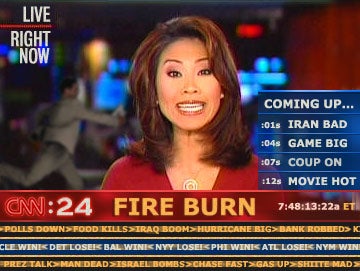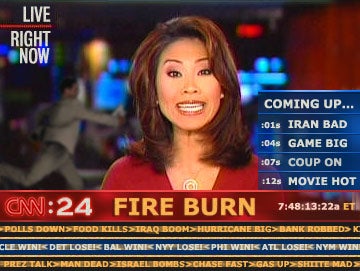ATLANTA—Last week, after a reported 65 million Americans learned of the bipartisan immigration bill with the breaking news report “Mexicans Stay,” it became apparent that the much- ballyhooed 24-second news cycle had come into its own. But now some media experts are questioning the conventional wisdom that says the quickening pace of reportage is providing more news to more people faster.

“Thinking back, the 24-hour news cycle seems glacially slow and simply incapable of covering our ever-changing world,” Slate media critic Jack Shafer said. “Yet I can’t help but think that segments that last less than four seconds are missing out on some nuance and context that the old 45-second pieces provided. When the media covers the story of a missing girl these days, are they reporting it with the depth and detail that they once did?”
CNN is widely credited with initiating the acceleration of the modern news cycle with the fall 2006 debut of its spin-off channel CNN:24, which provides a breaking news story, an update on that story, and a news recap all within 24 seconds. In addition to creating its groundbreaking format, CNN:24 broke many important stories with reports such as “Ford No Money Everyone Fired,” “Iraq Bomb Kill Truck,” “Country Hates Bush,” “Dow High Now,” and “Squirrel Water Skis.”
“TV news reporting has always been about breaking the story down into only the barest, most salient facts, but the breakneck pace of contemporary reportage doesn’t allow for that anymore,” said Professor Robert Kubey, director of the Center for Media Studies at Rutgers University. “Today’s ace reporter isn’t the one with the best command of the language, but the one who can say ’Congress!’ or ’Health care?’ or ’Slam dunk!’ with the most appropriate expression on his or her face.”
Now, the rest of the industry has followed suit, in some cases surpassing the pioneering cable-news channel in the quest for faster, louder, and flashier news. Within a month of CNN:24’s debut, MSNBC responded with its own 24-second news channel, MSNBC News Moment, which managed to pack in more than twice as many headlines.
A typical News Moment segment includes seven seconds of lead stories, four seconds of developing news, the “International Second,” “Weather on the 00:00:13s with Bob Van Dorn,” “The Fastest Four Seconds in Sports,” a two-second top stories recap, and wraps with four seconds of mixed entertainment and lifestyle pieces. In larger markets such as New York and Los Angeles, this last portion may be preempted by local news.
The changes have had a ripple effect throughout the media, inspiring everything from the somewhat more in-depth newsmagazine format of CBS’s 10 Minutes to the even more stripped-down Fox News Look. The latter repeats every 15 seconds, features more and simpler imagery, and forgoes the use of verbal language in favor of newscasters who gesture emphatically at video clips and hoot in approval or growl in derision, depending on the story.
The faster news cycle has also had a direct impact on newsmakers themselves. Speeches, public statements, and press releases have become markedly more brief and vague now that executives, politicians, and other public figures can pause to watch the recap of their speech in near-real time.
“When a sound bite is going to be a fifth of a second, you have to be much more careful with what you say,” said Gerald Conroy, press adviser to Democratic presidential candidate John Edwards. “We can’t have our candidate say ’Not only do illegal guns kill people in the inner cities faster than anything else, but more young blacks die of gunshot wounds than any other group,’ because the news will cut it to ’kill people’ or ’blacks die.’ That half-second quote is what the audience remembers, not your five-second explanation.”
Journalists themselves are also feeling the strain of having to file more stories more quickly.
“When I started in this business, I used to have 45 minutes to really dig into a story and check my facts,” said Ray Straatsma, a writer for usa2daybeta.com, the popular national newspaper’s recently updated online version, whose pages refresh with new headlines more than 70 times per minute. “Now I’ll get scooped by the competition if I don’t get my story to the editor in three to five seconds.”
While the changes have brought higher ratings and ad revenues to televised news, print newspapers have suffered greatly, due to the high cost of printing and distributing a new edition every 24 seconds.







